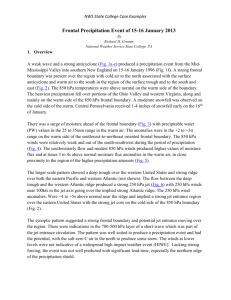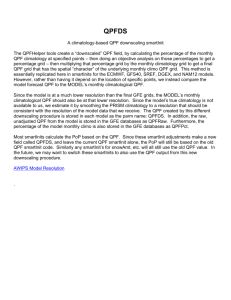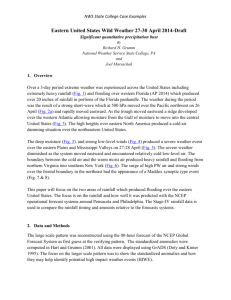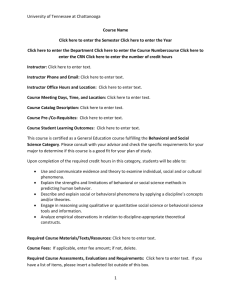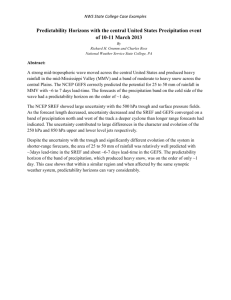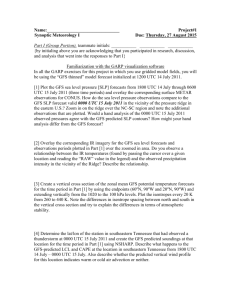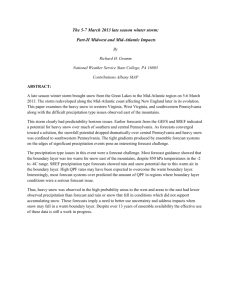18Mar2013
advertisement
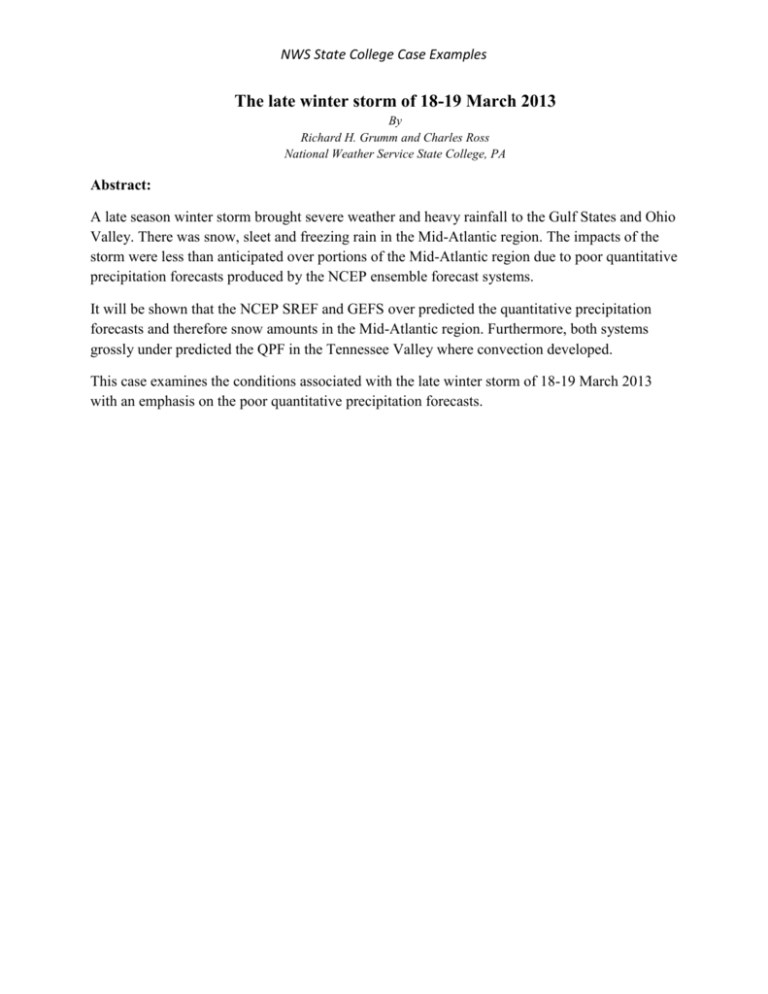
NWS State College Case Examples The late winter storm of 18-19 March 2013 By Richard H. Grumm and Charles Ross National Weather Service State College, PA Abstract: A late season winter storm brought severe weather and heavy rainfall to the Gulf States and Ohio Valley. There was snow, sleet and freezing rain in the Mid-Atlantic region. The impacts of the storm were less than anticipated over portions of the Mid-Atlantic region due to poor quantitative precipitation forecasts produced by the NCEP ensemble forecast systems. It will be shown that the NCEP SREF and GEFS over predicted the quantitative precipitation forecasts and therefore snow amounts in the Mid-Atlantic region. Furthermore, both systems grossly under predicted the QPF in the Tennessee Valley where convection developed. This case examines the conditions associated with the late winter storm of 18-19 March 2013 with an emphasis on the poor quantitative precipitation forecasts. NWS State College Case Examples 1. Overview A strong late season winter storm brought rain (Fig. 1), snow (Fig.2), and severe weather (Fig. 3) to the eastern United States on 18-19 March 2013. The event occurred as a strong 500 hPa shortwave (Fig. 4) moved southward across the eastern United States beneath a strong blocking anticyclone (Fig.4) over Greenland. This strong late season block, with the blocking anticyclone over Greenland produced some extreme values of the Arctic Oscillation (Fig. 5). The strong trough allowed for unseasonably cold air to move into the eastern United States while the trough of low pressure at lower levels allowed warm moist air to move into the Ohio Valley and portions of the northeast. The result was a strong late season winter storm producing snow and severe weather. This paper will document the pattern associated with the late winter storm of 18-19 March 2013. The focus will be on the pattern and standardized anomalies to put the event in context. An examination of forecasts is presented addressing quantitative precipitation amounts and winter precipitation type issues over the Mid-Atlantic region. . 2. METHOD AND DATA The large scale pattern was reconstructed using the Climate Forecasts System (CFS) as the first guess at the verifying pattern. The standardized anomalies were computed in Hart and Grumm (2001). All data were displayed using GrADS (Doty and Kinter 1995). The precipitation was estimated using the Stage-IV precipitation data in 6-hour increments to produce estimates of precipitation during the 6,12,24 and 36 hour periods centered on 1200 UTC 18 March 2013. Snowfall was retrieved from NWS public information statements. The NCEP GEFS and SREF data were used to show the larger scale forecasts of the pattern, the QPF, precipitation types, and uncertainty. The focus is on shorter-range forecasts and with the exception of mean QPF and probabilities of exceed 25 and 50mm QPF, only limited GEFS data is shown. Additionally, SREF data from 07 through 10 March were examined to show the low predictability of the synoptic features. Though QPF and probabilities were limited to forecasts from 16-18 March 2013 focusing on the QPF and snow potential over the Mid-Atlantic region on 18 March.. GEFS data from 12-18 March were examined in the same context as the SREF. Due to the similarities in most fields the data shown here focus on how the GEFS and SREF precipitation NWS State College Case Examples shields evolved. This helped identify the different predictability horizons of the two broader areas of precipitation. The precipitation errors were computed using Forecast minus observed (F-O). Thus positive errors indicated a wet forecast and negative values represented a dry forecast. The ensemble mean QPF from both the SREF and GEFS was verified using the Stage-IV data as ground truth. For each system, the Stage-IV data was re-gridded to the forecast systems grid. 3. Pattern overview The large scale pattern over North America (Fig. 4) showed the strong 500 hPa trough moving beneath the blocking high latitude anticyclone over Greenland. During the evolution of the winter storm over eastern North America, the 500 hPa height anomalies rose to +4 to +5s above normal with 500 hPa heights over 5520 m. Though not shown, mean-sea level pressure over Greenland peaked at over 1064 hPa at 19/0600 UTC. The strong high latitude anticyclone over northeastern North America and Greenland produced extreme values in the AO (Fig. 5) and displaced cold air into southeastern North America (Fig. 4 & Fig 6). As the 500 hPa trough moved southeastward into the eastern United States (Fig. 4) it pulled a plume of warm (Fig. 6) moist air (Fig. 7) from the Gulf of Mexico, into the Ohio Valley and then up the East Coast. The precipitable water (PW:Fig. 7) values were in the 20-30mm range and in the +1 to +2s above normal range in the warm air ahead of the advancing colder and drier air. A strong low-level jet developed in the warm air air (Fig. 8c-d) in the gradient between the pressure trough and area of low pressure over the Great Lakes (Fig. 9) and the retreating anticyclone over the northeastern United States and southeastern Canada. The surface anticyclone to the north played a critical role in the late season snow fall (Fig. 2) over Pennsylvania and the northeastern United States. A steadfast rule of winter precipitation is “forecast the anticyclone, forecast the snow”, a rule well defined in studies of significant East Coast Winter Storms (ECWS) by Kocin and Uccellini (2004) which typically showed anticyclone over New England as critical elements for frontal circulations and the maintenance of low-level cold air. The severe weather event in the southern United States (Fig. 3) was in close proximity to the plume of above normal PW air (Fig. 7) and the strong low-level jet (Fig. 8). The warm moist air and strong shear likely played a critical role in the severe weather in the southern United States. 4. Forecasts The SREF forecasts from 6 cycles over a relatively short time horizon are used here including SREF forecasts from 16/0900, 17/0300-17/1200 and 18/0300 UTC. The 850 hPa temperature forecasts show the issues with the frontal and cold air damming situation in the Mid-Atlantic region (Fig. 9). The spread about the mean (not shown) would reveal some issues with NWS State College Case Examples precipitation type clearer. But as shown, these data show the strong frontal system over the MidAtlantic region south of the surface anticyclone and the surge of cold air with the midtropospheric shortwave. The evolution of the QPF fields from these forecasts (Figs. 10 & 11) show the probability of 15mm (~0.60 inches) of QPF in the 12-hour period of maximum QPF and the 24-hour period of potential QPF when the storm was predicted to impact Pennsylvania. These data show that the threat of 15mm increased from SREFs initialized on and after 17/0300 UTC, especially over western Pennsylvania. The 15mm contour was selected as it would provide, in a quick 10:1 snow ratio, the potential for warning criteria snow. However, not all the QPF was predicted to fall as snow. The 24-hour forecasts were a bit more robust with slightly higher probabilities of 15mm or more QPF. The probability of an inch or more of QPF was generally under 20 percent in most SREF runs and is not shown. The SREF probabilities of snow, freezing rain, and ice pellets (sleet) are shown in Figures 12-14. These data imply that more members forecast snow than any other type. The snow probabilities slowly came as forecast length decreased focusing 3-5 inches of snow over northern and western Pennsylvania. Note the gradual evolution of the higher snow amounts based on the mean QPF predicted to fall as snow. The freezing rain probabilities were higher to the south over southwestern Pennsylvania and West Virginia. These SREF forecasts indicated a mixed event over western Pennsylvania with rain (not shown) dominating over the southwestern areas, west of the mountains after about 1500 UTC on 18 March. The data in Table 1 were extracted from the SREF ensemble members. These data show that 15mm of QPF was a high probability forecast, though skewed by some wet members. The probability of 25 mm or more QPF was highest at the shortest forecast length. Total observed amounts near this point were around 10 mm. The SREF was far too wet. NWS State College Case Examples Cycle 09Z16MAR2013 12-hr to 00Z 12 hour to 12Z 24 hour Mean Probability Mean 2 Probability 3 Mean 4 10.03 28.50 4.82 4.70 14.29 Probability 14.28 03Z17MAR2013 15.04 52.38 6.54 4.00 21.59 23.81 09Z17MAR2013 19.12 76.19 3.37 0.00 22.25 38.09 15Z17MAR2013 17.35 57.14 5.38 0.00 22.73 33.33 21Z17MAR2013 17.03 61.90 6.66 9.50 23.69 42.85 03Z18MAR2013 18.64 76.19 8.99 4.70 27.64 71.43 Table 1. Data from SREF members near State College, PA showing the mean QPF and the probability of exceeding 15mm in the two 12 hour periods and exceeding 25mm in the 24 hour period. The 12 hour periods match the Figure 10 and 11 spanning 1200 UTC 18 March through 0000 UTC 19 March and 0000-1200 UTC 19 March. The 24 hour period spans both times. The observed QPE from the Stage-IV data from 18/1200 through 19/0000 UTC show the QPF error patterns (Fig. 15). Similar to the point data (Table 1) these data show large negative errors over Kentucky and Tennessee and large positive errors over Pennsylvania. Some of the larger QPF errors were observed with shorter range forecasts (Fig. 15d-f). The GEFS 24-hour QPF from 6 cycles is shown in Figure 16. The GEFS suffered from the same errors (Figs. 17 & 18) as the SREF. Though not shown, the period of heaviest QPF from the 12hour period ending at 19/0000 UTC and this was the period of largest QPF errors in the GEFS over Kentucky and Tennessee (Fig. 17). Note the 24-hours over that region were smaller likely due to some timing issues. But the overall QPF error patterns in the GEFS and SREF were quite similar. 5. Summary NWS State College Case Examples A poorly forecast precipitation event affect the Mid-Atlantic region on 18 March 2013. Unfortunately, neither the GEFS or SREF showed better skill at shorter (9-12 hours) before the event than at longer ranges (~days). It is unclear why the QPF errors over the Mid-Atlantic region were so large. The over forecast QPF lead to over forecasts of snow and freezing rainfall. Both NCEP EFSs over predicted the amount of QPF with this event over the Mid-Atlantic region. An examination of the SREF point data in Table 1 shows that the largest errors were observed with shorter range forecasts. This is odd as generally, forecasts tend to get more skillful as forecast length decreases. In this case the forecasts got poorer. Viewed over the eastern United States, a pattern emerges with under prediction errors in Kentucky and Tennessee and over prediction errors in the Mid-Atlantic region (Figs. 15,17,18). The source of the error may be in under predicting the potential for convection over Tennessee and Kentucky which allowed deep moisture in the ensemble model members “atmospheres” to be available to produce grid scale precipitation in the frontal zone farther north. An examination of radar showed the evolution of a line of convection over Kentucky and Tennessee around 18/1000 UTC which moved westward over time (Fig. 19). There was stronger convection farther to the south, associated with severe weather (Fig. 3) though the QPF errors were not as large in that region. It is possible that strong convection to the south and west may have depleted the larger scale moisture plume as it moved over the Mid-Atlantic region. Other clues were present to potentially limit the snow forecasts including a) the lack of a strong low-level easterly jet which accompanies the majority of heavy snow events in the Mid-Atlantic region; and b) the frequently observed precipitation minimum areas often associated with secondary redevelopment events along the East Coast. These general rules may often fail and an ensemble approach should work well, though it failed in this event. This event illustrates that there are some limits of predictability that only become clear after the e event has occurred. Clearly, in the Mid-Atlantic region, the QPFs in all the systems were quite poor and overestimated the precipitation and therefore both the snow, freezing rain, and rain threat. An examination of NAM, GFS and RAP data was conducted too. The RAP short-term forecasts grossly over predicted the QPF at extremely short ranges. This despite some relatively useful synthetic radar evolutions the RAP QPFs were of limited value. It is not clear why this event, from a QPF perspective was so poorly forecast by all the NCEP systems. An old adage of forecasting is that when the models and guidance perform poorly, so do forecasters using these data. This case is illustrative of how poorly guidance can perform at very short ranges. It also implies that comparing skill scores of forecasts should include some normalization relative to the performance of guidance during said event. Not all events are as skillfully forecast and comparative forecasts not addressing this are of little or no intrinsic value. NWS State College Case Examples 6. Acknowledgements All those who worked this event, found some limitations to the data and inconsistencies. Barry Lambert contributed some theories as to the reasons the models over predicted the QPF including the convection to the southwest. 7. References Doty, B.E. and J.L. Kinter III, 1995: Geophysical Data Analysis and Visualization using GrADS. Visualization Techniques in Space and Atmospheric Sciences, eds. E.P. Szuszczewicz and J.H. Bredekamp, NASA, Washington, D.C., 209-219. Kalnay, Eugenia, Stephen J. Lord, Ronald D. McPherson, 1998: Maturity of Operational Numerical Weather Prediction: Medium Range. Bull. Amer. Meteor. Soc., 79, 2753– 2769. NWS State College Case Examples Figure 1. Stage-IV accumulated liquid equivalent precipitation (mm) from 0000 UTC 18 through 0600 UTC 19 March 2013. Return to text. NWS State College Case Examples Figure 2 NWS State College Case Examples Figure 3. Storm reports from the Storm Prediction Center. NWS State College Case Examples Figure 4. GFS 00-hour forecasts of 500 hPa heights (m) and 500 hPa height standardized anomalies in 12 hour increments from 0000 UTC 17 March 2013 through 1200 UTC 19 March 2013. Return to text. NWS State College Case Examples Figure 5. CPC daily observed Arctic Oscillation Values. Return to text. NWS State College Case Examples Figure 6. As in Figure 4 except for 850 hPa temperatures and temperature anomalies in 6-hour increments from 0000 UTC 18 March through 0600 UTC 19 March 2013. Return to text. NWS State College Case Examples Figure 7. Return to text. NWS State College Case Examples Figure 8. Return to text. NWS State College Case Examples Figure 9. Return to text. NWS State College Case Examples Figure 10. As in Figure 9 except the probability of 15 mm or more QPF in the 12-hour period ending at 0000 UTC 19 March 2013. Black dot is the location of State College used to make point data summaries. Return to text. NWS State College Case Examples Figure 11. As in Figure 9 except for 15mm or more QPF in 24 hour period ending at 1200 UTC 19 March 2013. Return to text. NWS State College Case Examples Figure 12. As in Figure 10 except for the probability of snow and the mean snow precipitation (inches 10x) valid for the period of 1200 UTC 18 March through 0600 UTC 19 March 2013. Return to text. NWS State College Case Examples Figure 13. As in Figure 12 except for freezing rain as the dominant precipitation type. Return to text. NWS State College Case Examples Figure 14. As in Figure 12 except for ice pellets or sleet. Return. NWS State College Case Examples Figure 15. As in Figure 14 except for SREF mean QPF error when subtracting out the observed Stage-IV data for the period of 1800 UTC 18 March through 0000 UTC 19 March 2013. Values in (mm) return to text. NWS State College Case Examples Figure 16. As in Figure 14 except for NCEP GEFS forecasts of ensemble mean QPF (shaded) and each members 25mm contour (thin colored lines) and the ensemble mean 25mm contour valid for the 24 hour period of 1200 UTC 18 March to 1200 UTC 19 March 2013 from GEFS initialized at a) 1200 UTC 15 March, b) 0000 UTC 16 March, c) 1200 UTC 16 March, d) 0000 UTC 17 March, e) 1200 UTC 17 March, and f) 0000 UTC 18 March 2013. Return to text. NWS State College Case Examples Figure 17. As in Figure 15 except for GEFS 12-hour mean precipitation errors from GEFS initialized at a) 1200 UTC 15 March, b) 0000 UTC 16 March, c) 1200 UTC 16 March, d) 0000 UTC 17 March, e) 1200 UTC 17 March, and f) 0000 UTC 18 March 2013. Return to text. NWS State College Case Examples Figure 18. As in Figure 17 except for 24-hour QPF errors ending at 1200 UTC 19 March 2013. Return to text. NWS State College Case Examples Figure 19. Select radar images showing the evolution of the composite reflectivity. The focus was on convection over Tennesesse and Kentuck. Data from the NMQ-Q2 site showing composite reflectivity on 18 March from (top left) 0955, (top right) 1255, (bottom left) 1555 and (bottom right) 1855 UTC. Return to text. NWS State College Case Examples Figure A-1 Verifying QPF Grid (mm) used to subtract from GEFS and SREF MEAN forecasts. NWS State College Case Examples Figure A-II Zoomed in view of the surface anticyclone over Greenland. Used for text discussion and reference.
